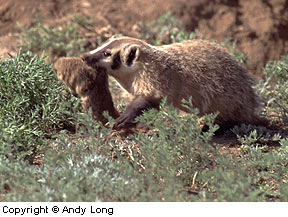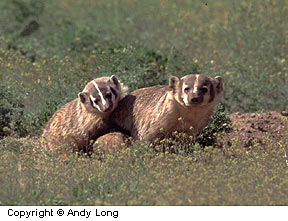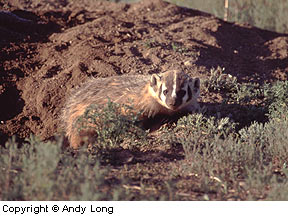
Remembering back to childhood, almost everyone dug in the dirt at one time or another.The reasons were many–just to dig a hole, to bury something, to see if you could find something, or to find that quick route to China.Whatever the reason, we outgrew it.However, some creatures never outgrow the urge to dig.A prime example is the badger.If an excavation firm could hire a bunch of badgers, they would save considerable money on equipment and shovels.These animals are built for digging and have earned the nickname “nature’s digging machine.”
From the day they’re born to the day they die, badgers are in and out of holes in the ground.Holes serve a variety of purposes for them—a home, a restaurant, a rest room, and an escape route.Understandably, one hole isn’t enough.During the summer months, a badger may go through a den a day, not sleeping in the same place two days in a row.Their mobile lifestyle enables badgers to move around their territory looking for different food sources each day.In cooler weather, though, they usually stay longer in a single den.Then, they don’t want to expend too much energy merely finding and digging out new holes.Unlike many other animals in the wild, the badger will dig a hole and cover its feces when it goes to the bathroom.Not much is known about why they do this, but it may be to prevent their prey from finding evidence that they’re in the area.

Another time badgers use the same hole for more than one day is when a female has her cubs, usually from one to five.At this time, they’ll settle into a sole burrow for about a month, until the young can venture out with the mother as she seeks another home on the range – and another and another and another.This is the best time to try to photograph badgers.If you know of an area with good badger activity, you might be able to find one on any given day.However, when a female has given birth, and you discover her or her young, you know you can expect to find them in the same area for several weeks.
The badger has taken the idea of being an unwelcome guest to a new level.Usually, most small animals that are prey foods have to be wary only while they’re above ground–that is, unless a badger is in the area.If a badger knows one of its favorite meals – ground squirrels, pocket gophers, marmots or prairie dogs – is at home, it will dig into their hole and make a meal of the occupants.Some of the badger’s digging strategies are quite ingenious.When it goes after ground squirrels, for example, it might plug all the doors to the squirrel’s burrow but one before it proceeds to dig out the squirrel.Another technique the badger uses is to dig a connecting tunnel into the one remaining entrance to the prey’s burrow and just wait for supper to enter or leave.
One popular meal of the badger that necessitates careful hunting is the rattlesnake.Because of its extremely thick coat, a badger is unharmed by venom unless the snake strikes it directly on its nose, the only place where its skin shows. Another interesting fact about badgers is that they have the ability to dive and swim in their efforts to catch a meal.Their affinity for water also shows on very hot days when they will sprawl out in shallow water to cool off.

In an interesting pairing, coyotes–that, along with grizzly bears, are the only predators of badgers–will watch a badger hunting in order to steal the badger’s prey as the prey pops up from an escape exit trying to avoid capture.Without many predators of their own, badgers don’t have too much to worry about in terms of their own protection.Occasionally, a coyote or grizzly will try to catch a badger, but they’re rarely successful.When confronted by a predator, badgers will try to escape to a den that the predator can’t enter.If it’s not near one of its own burrows, a badger will take instant advantage of any hesitation on the part of the attacker to dig itself into the soil.If all else fails, a badger will back itself into a corner–if one is available–and fight fiercely while snarling, growling, and hissing.However, despite its ferocious self-defense, a badger would rather retreat.
In the United States, badgers reside primarily in the western states.Some excellent locations for finding and photographing them include the Arapaho National Wildlife Refuge in Colorado (in the prairie dog town near the turnoff to the old barn) and the Snake River Birds of Prey Area in Idaho.In fact, the Snake River Birds of Prey Area, located in the Boise area, is home to the largest badger population in the country.
By Andy Long

Leave a Reply